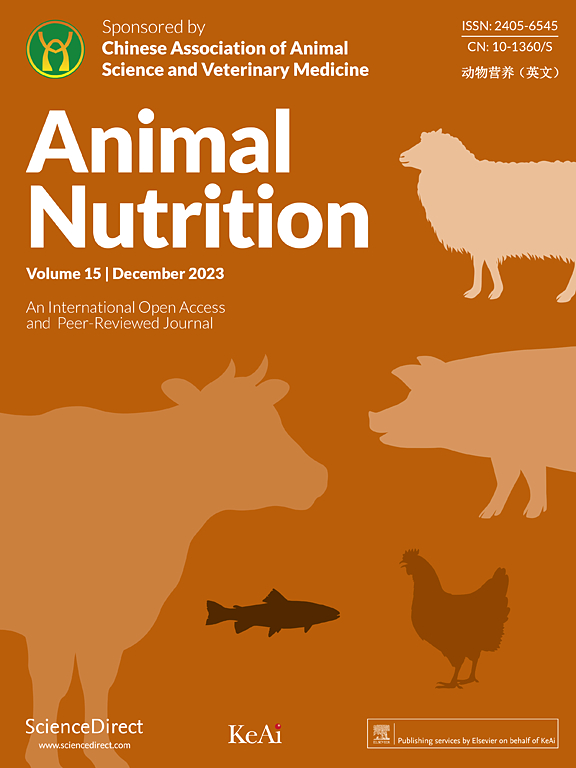Assessment of four different dietary amino acid profiles recommended for ISA Brown layer hens: a validation study
IF 6.1
1区 农林科学
Q1 AGRICULTURE, DAIRY & ANIMAL SCIENCE
引用次数: 0
Abstract
The current feeding study was designed to validate the two dietary essential amino acid profiles (EAAP) established based on linear broken-line (LBL) and quadratic broken-line (QBL) models, in a previous study, against Evonik (AMINOHen) and breeder recommendations for ISA Brown layers for peak production (PP, 20 to 44 weeks), and post peak production (post PP, 44 to 75 weeks). The EAAP based on LBL models on average had 19.5% and 26.0% lower digestible AA (Lys, Met + Cys, Thr, Trp, Ile and Val), than the EAAP based on QBL models for PP and post PP, respectively. The EAAP based on AMINOHen and breeder recommendation had lower digestible AA than QBL, and higher EAAP than LBL models for both production phases. At 20 weeks of age 224 ISA Brown layer hens were weighed and randomly allocated to individual battery cages. Each of the four diets was replicated 8 times with 7 birds per replicate. Egg production was recorded daily, and egg weights were measured at the end of each week. Feed consumption was measured at the end of each period. The egg production rate was not significantly affected by the diets and remained at around 98.0% (PP) and 95.0% (post PP). Birds fed diets based on LBL recommendation consistently laid smaller eggs, resulting in a lower egg mass (59.8 vs. 62.0 g egg/hen per day during PP, and 60.3 vs. 63.0 g egg/hen per day during post PP; < 0.05). Diets had no significant effect on feed intake and body weight ( > 0.05). The highest FCR during PP ( = 0.067) and post PP ( < 0.05) was recorded for the birds offered diets based on LBL recommendation. In conclusion, all four EAAP tested in this study support an above average egg production rate. However, the EAAP based on LBL models may potentially decrease the input feed cost per kilogram of eggs but are not set to optimise FCR and maximise egg mass.对推荐用于 ISA 褐羽蛋鸡的四种不同日粮氨基酸组合的评估:一项验证研究
目前的饲喂研究旨在验证先前研究中根据线性折线(LBL)和二次折线(QBL)模型建立的两种日粮必需氨基酸谱(EAAP),与赢创(AMINOHen)和育种家对 ISA 棕羽蛋鸡生产高峰期(PP,20 至 44 周)和生产高峰期后(PP,44 至 75 周)的建议进行对比。基于 LBL 模型的 EAAP 平均可消化 AA(Lys、Met + Cys、Thr、Trp、Ile 和 Val)比基于 QBL 模型的 EAAP 分别低 19.5% 和 26.0%。在两个生产阶段,基于 AMINOHen 和饲养者建议的 EAAP 的可消化 AA 均低于 QBL,而 EAAP 则高于 LBL 模型。在 20 周龄时,对 224 只 ISA 棕色蛋鸡称重并随机分配到单个电池笼中。四种日粮各重复 8 次,每次 7 只。每天记录产蛋量,每周末测量蛋重。每期结束时测量饲料消耗量。日粮对产蛋率的影响不大,产蛋率保持在 98.0%(PP)和 95.0%(PP 后)左右。饲喂基于 LBL 建议的日粮的家禽产蛋量一直较小,导致蛋重较低(PP 期为 59.8 vs. 62.0 g egg/hen/日,PP 期后为 60.3 vs. 63.0 g egg/hen/日;< 0.05)。日粮对采食量和体重没有明显影响(> 0.05)。在 PP 期间(= 0.067)和 PP 后(< 0.05),根据 LBL 推荐日粮饲喂的鸡的 FCR 最高。总之,本研究中测试的所有四种 EAAP 均支持高于平均水平的产蛋率。然而,基于 LBL 模型的 EAAP 有可能降低每公斤鸡蛋的投入饲料成本,但不能优化 FCR 和最大化蛋重。
本文章由计算机程序翻译,如有差异,请以英文原文为准。
求助全文
约1分钟内获得全文
求助全文
来源期刊

Animal Nutrition
Agricultural and Biological Sciences-Animal Science and Zoology
CiteScore
7.40
自引率
3.20%
发文量
172
审稿时长
12 weeks
期刊介绍:
Animal Nutrition encompasses the full gamut of animal nutritional sciences and reviews including, but not limited to, fundamental aspects of animal nutrition such as nutritional requirements, metabolic studies, body composition, energetics, immunology, neuroscience, microbiology, genetics and molecular and cell biology related to nutrition, and more applied aspects of animal nutrition, such as raw material evaluation, feed additives, nutritive value of novel ingredients and feed safety.
 求助内容:
求助内容: 应助结果提醒方式:
应助结果提醒方式:


